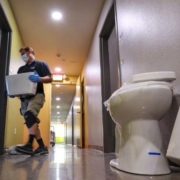The San Diego County Water Authority has secured $3 million in grant funds to install water-saving devices — water-efficient toilets and smart irrigation controllers — in underrepresented communities across the region, bolstering the agency’s long-running efforts to enhance water affordability.
The Water Authority will use the money to install 7,300 high-efficiency toilets and smart irrigation controllers covering about 4,000 locations, saving more than 6,000 acre-feet of water and helping enhance water efficiency and affordability for vulnerable customers. The funds are from the California Department of Water Resources’ Urban Community Drought Relief Grant program, designed to advance Governor Gavin Newsom’s strategy to adapt California’s water supply for a hotter and drier future.
Safe, reliable, affordable water
“This is another big step toward our goal of ensuring that everyone in San Diego County has access to safe, reliable and affordable water,” said Water Authority Board Chair Mel Katz. “Helping customers improve water efficiency ultimately saves them money and protects our most precious natural resource.”
In 2022, the Water Authority secured $25 million to cover overdue residential water bills resulting from the economic impacts of COVID-19. The Water Authority also operates an industry-leading asset management program designed to avoid the extreme costs of emergency repairs on large-scale water lines. And, the agency is advocating in Washington, D.C., for federal funds to defray the cost of generational upgrades to local dams and reservoirs.
Water-saving devices
The Water Authority’s Water-Use-Efficiency Direct Installation Program is designed to save residents money on water costs. To be eligible for the direct-install program, residents in manufactured housing communities, multifamily and single-family homes must be a customer within the Water Authority service area. Details and how to participate: www.synergycompanies.com/utility-program/sdcwa-dip or call 888-272-8394.
Reduce water use by 60%
The direct-install program conserves water by replacing inefficient toilets with high-efficiency models through professional installation at no cost to participants. According to the U.S. EPA, the replacement of older toilets with high-efficiency models can reduce water use by up to 60%. The initiative also includes installing smart irrigation controllers at no cost and providing education on outdoor water-use efficiency. Smart irrigation controllers can make irrigation schedule adjustments more convenient and water-efficient by using local weather data and landscape conditions to tailor the amount, frequency, and timing of landscape watering.
The grant funds will extend the life of the Water Authority’s existing program that has installed 2,213 water-efficient toilets over the past 12 months. The program is funded and implemented through a partnership between the Water Authority, the Metropolitan Water District of Southern California and San Diego Gas and Electric.



